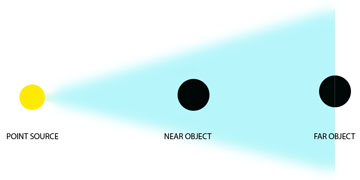 The Inverse Square Law is very simple but also very important to photographers. It states that as an object is moved away from a point source of light, the decrease in the light energy falling on it is inversely proportional to the square of the distance between the source and the object. In other words, as shown in the diagram, at distance D the light energy falling on the area A is spread over the area B at a distance of 2D. Since area B is four times greater than area B, the intensity of the light at distance 2D is one quarter of that at distance D. The decrease in illumination is caused primarily by the spreading of the beam of light over a larger area.It is important to note the use of the term "point source". This is a theoretical source of infinitely small size which emits light uniformly in all directions.
The Inverse Square Law is very simple but also very important to photographers. It states that as an object is moved away from a point source of light, the decrease in the light energy falling on it is inversely proportional to the square of the distance between the source and the object. In other words, as shown in the diagram, at distance D the light energy falling on the area A is spread over the area B at a distance of 2D. Since area B is four times greater than area B, the intensity of the light at distance 2D is one quarter of that at distance D. The decrease in illumination is caused primarily by the spreading of the beam of light over a larger area.It is important to note the use of the term "point source". This is a theoretical source of infinitely small size which emits light uniformly in all directions.
 When a highly focused beam of light is used, the situation is rather different because more of the energy emitted by the source falls on an illuminated object. However, focused sources of this nature are rarely used in photography because they produce harsh light and unsightly shadow effects.
When a highly focused beam of light is used, the situation is rather different because more of the energy emitted by the source falls on an illuminated object. However, focused sources of this nature are rarely used in photography because they produce harsh light and unsightly shadow effects.
In the second diagram, on the right, it is easy to see how light from a typical photographic source spreads as it reaches out to more distant objects. The further object in the diagram therefore receives only about one quarter of the light striking the nearer object.






